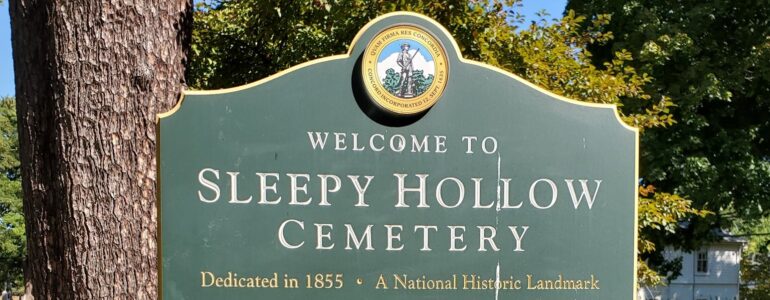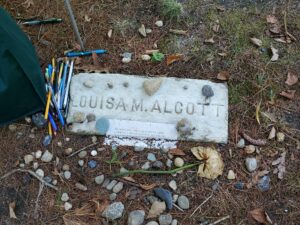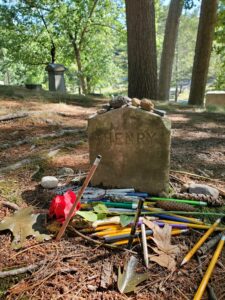
A Writer’s Visit to Author’s Ridge
A recent trip I took to New England to enjoy the Maine seacoast and eat lobster roll also included a stop to indulge the wistful writer in me. Sleepy Hollow Cemetery in Concord, Massachusetts, is where I set my sights. Am I the only weirdo who felt giddy to visit the graves of a bunch of dead authors? Apparently not, because I ran into others doing the same and saw the treasure trove of offerings left at the headstones. Slips of paper with quotes and scribbled notes. Writing utensils, flowers and sticks and rocks. These are not just any authors, but classic essayists, poets, thinkers of the 19th century that created their work in the same place they were buried and who left us with their prose to ponder over forevermore.
Henry David Thoreau, Ralph Waldo Emerson, Louisa May Alcott, Nathanial Hawthorne to name a few, along with some of their family members, are buried within a stone’s throw of one another in Author’s Ridge, a part of the Sleepy Hollow Cemetery that is not inviting, in fact, you pretty much have to know about it in advance and hunt it down. There is no neon sign guiding you in. The cemetery itself was in part, inspired by Emerson’s writings and he even gave a speech at the dedication ceremony in 1855.
When I climbed the handful of stairs that leads to Author’s Ridge far away from the cemetery entrance, I hunted down all of the grave sites I wanted to see, helping a lady find the ones I had already found and she helping me with the rest. Emerson, Hawthorne, all of them. Then another woman ambled over— looking confused, a large cloth purse slung over her shoulder.
“Looking for anyone in particular?” I asked her.
She sighed a big sigh. “I’m looking for everyone.”
We both laughed and then she said, “Alcott is who I’m mainly here for.”
Louisa May Alcott, author of the infamous Little Women, still has a home standing for tourists to visit just a short jaunt from w here she is buried. The story has enduring appeal, existing in a simpler setting than most of us experience today but with themes that remain relatable.
here she is buried. The story has enduring appeal, existing in a simpler setting than most of us experience today but with themes that remain relatable.
“Alcott is right here,” I pointed to the flat, white stone. The woman immediately threw herself down at the side of the grave and pulled out a huge sunflower from her bag, carefully unwrapping the crepe paper covering it before laying it down.
“She is my spirit mother.”
She looked as if she could cry, and she sat their mourning over the grave.
“Can I take your picture?” I asked her. She obliged with a big smile. I wanted to capture this moment that I was living through the eyes of this woman I just met who was also drawn to this patch of cemetery from wherever it was that she was from.
Shortly before my trip, I read Thoreau’s 1862 essay, Autumnal Tints. (Translation for the year 2022: I listened to it in the audio book version from the Libby app on my Android phone.) While listening to the narration, I was awestruck at the thought of Thoreau sitting in a small cabin in Concord, Mass, observing the fall foliage, taking it all in and being so grounded and so very inspired as to write a big, bodacious, beautiful essay on one simple topic: the hues of fall. An entire spray of 19th century prose encapsulating the mind’s eye of a writer not distracted by television, internet, fast food ads or gadgetry of any sort. I wondered if I could ever be in such a mind space and to ever be able to write from a similar vantage point as he did when he penned this essay.
“October is the month for painted leaves. Their rich glow now flashes round the world. As fruits and leaves and the day itself acquire a bright tint just before they fall, so the year near its setting. October is its sunset sky; November the later twilight.”
I had thrown myself to my knees before Thoreau’s grave when I found it just minutes pri or—almost exactly in the same fashion the Alcott lady fan had done. I did not pull out a flower but an unsharpened pencil. I had planned to bring a pencil with my midwestern hometown’s name on it—from our local bicycle club—but typical of me, I forgot it when I packed my travel bags. So, I bought a pencil earlier in the day from the Witch Museum gift shop in Salem. As I purposefully drove the pencil into the dirt in front of the grave stone, I felt like it was a sacrament to this great writer, as if this act could channel his talent and his writing-wits through the pencil and into my veins. I felt a twinge, a few tears wanting to escape my eyes. And I felt silly for feeling that.
or—almost exactly in the same fashion the Alcott lady fan had done. I did not pull out a flower but an unsharpened pencil. I had planned to bring a pencil with my midwestern hometown’s name on it—from our local bicycle club—but typical of me, I forgot it when I packed my travel bags. So, I bought a pencil earlier in the day from the Witch Museum gift shop in Salem. As I purposefully drove the pencil into the dirt in front of the grave stone, I felt like it was a sacrament to this great writer, as if this act could channel his talent and his writing-wits through the pencil and into my veins. I felt a twinge, a few tears wanting to escape my eyes. And I felt silly for feeling that.
I said goodbye to the Alcott lady fan and circled back to the Thoreau grave one last time. I said a silent Al-Fatiha (Muslim prayer) and stepped out to find my way back to the rental car I had parked about a 10-minute walk from the graveyard entrance. As I looked down, I saw a single acorn at my feet. A lovely yet simple acorn. I looked around me and saw no other acorns. Just this one. Without thinking, I picked it up and put it into my pocket. I stopped and looked back at the grave stone and said, “thanks, guy!”
Not sure if the famous dead ecologist-author-legend extraordinaire left me a souvenir, but I choose to believe that he did. And I will keep it close by on my writing desk when I scrutinize myself… when I make excuses as to why I can’t write today… as I question my methods and my madness… and all the other things that happen to writers like me when we put pen to paper or open up Word on our laptops. And I’ll keep trying. And I’ll keep writing.
About the Author
Don't Miss the Next Great Post
If you enjoyed this blog post, subscribe below, and you'll receive an automatic email update when we publish new content.

